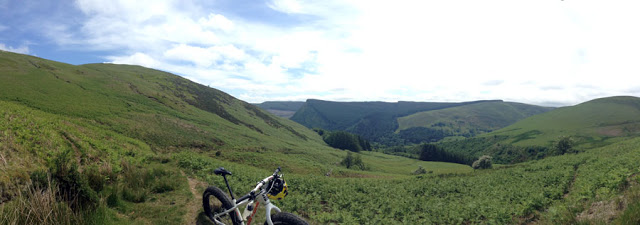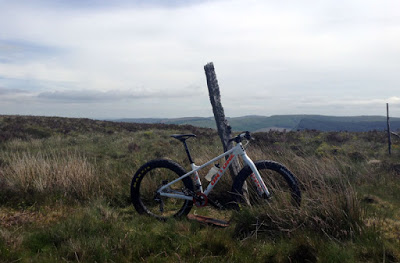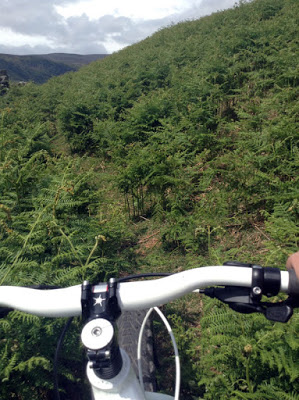If you were ever unfortunate enough to watch the X Files, you’ll know that they were fond of telling us that “The truth is out there” but sadly, they never actually bothered to clarify quite where it was. With no clues forthcoming, I decided to take my personal search for the ‘truth’ to the Berwyn Mountains.
For those who aren’t familiar with the Berwyns, imagine a huge green island rising from an even brighter green sea. Its flanks and spine are criss-crossed with the scars of a rich history in both trade and agriculture. There’s no sharp edges here, nothing pointy or jagged, time has sanded the rough edges away from the mountains leaving curvaceous valleys that rise and fall in a seemingly never ending wave. The only inhabitants are woolly or feathered and for much of the year you can enjoy it all in a blissful solitude that’s increasingly difficult to find … they’re also the location of numerous UFO sightings, so they seemed quite appropriate.
 |
| What you think is the bottom, isn’t – it’s a long way down. |
An initial bounce or two round the yard had done little to convince me one way or the other as to whether a fat bike is suited to the role of ‘all rounder’. It rolled okay on the relatively smooth, flat gravel, the expected tendency to self-steer at low speeds was present but easily ignored and thankfully all the mechanical bits worked as intended … I didn’t really have any excuse not to go and ride it properly.
The first climb was as first climbs often are – steep and seemingly never ending. The initial 300 metres were fine but as the gradient increased, the track became rougher until I begrudgingly admitted defeat, got off and started on a 3km push. A bikes willingness to be shoved and manhandled up an unhelpful hill isn’t generally something that receives an out of ten score in bike magazines but this isn’t MBR, it’s Bear Bones and pushing goes with the territory. To the uninitiated, this may seem like a strange thing but some bikes do lend themselves to pushing better than others and after 3km, I can say that this is a good one. Whether it’s the low centre of gravity, the 4″ tyres or something else, I don’t know but it does push very easily.
 |
| At home amongst the boggy bits. |
Everyone had told me that the 4″ tyres would come in to their own once the ground became squashy, so luckily a misguided turn gave me the opportunity to sample the floating delights of fat tyres and seeing as I had to retrace my steps after a few 100 metres, I got to do it twice. The particular section of track in question, would usually have stopped those ‘brave’ enough to attempt to cycle across it dead in their soggy tracks but not this time. As the ground got wetter, I kept expecting forward progress to stop but it didn’t, we just kept on plodding through until we reached dry land – result.
 |
| Yes, it’s a bridleway. |
Our next section of note occurred a few miles further on and at first appeared to be no more than a slightly rough bridleway with enough gradient to make pedalling unnecessary but how quickly things can alter. The gradient changed from not pedalling to gentle braking and small stones morphed into big stones before eventually becoming really, really big stones with added rock steps for good measure. As the ground got more interesting, so the angle of descent continued to steepen, I expected things to quieten down as I entered a wood on the lower slopes but no, the only change was the addition of a series of switchback corners and the occasional bonus root snaking through the stone. Anyone who’s ever ridden a rigid bike down something similar can testify that (a) you take a bit of a battering and (b) to minimise the battering, line choice becomes an important consideration … it’s not a situation where you want to sacrifice your ability to be accurate, for an increase in speed. Now, while I didn’t exactly float down the trail (at the end of the day, it’s still a rigid bike), I was able to take a few more liberties without thinking it was going to result in imminent head – floor interface. Sounds ideal? Well, nearly – you still need to be aware that although the cavernous volume of the tyres does take the sting out of most things they come into contact with, you still need to consider the amount of undamped rebound a tyre this size produces and act accordingly. It’s not enough to cause any undue concern but it will make its presence felt, meaning that you can’t throw caution to the wind completely as is sometimes mentioned.
The final leg of the day was probably the least surprising but maybe the most disappointing … we hit a tarmac climb. It’s obvious that a bike with 70mm wide rims and 4″ tyres running at 12psi is always going to require a little coaxing when it comes to climbing and it did. What I wasn’t really prepared for was the odd effect these components would have on gearing. Usually, you change to a lower gear as things become steeper, this then enables you to keep pedalling at a similar rate with no extra effort. If things get even steeper, select another gear, carry on and repeat the procedure until you stand triumphantly at the top … not this time. Instead, it appeared (and felt) that every time you selected a lower gear, any mechanical advantage gained was instantly ‘swallowed up’ by the tyres … another click, same thing and another and another. The end result was pedalling up hill in the lowest gear available but feeling like you were 8 gears higher – very disconcerting. I’m usually a middle-ring kind of chap, if I have a granny fitted I tend to view it as emergency use and only to be used on special occasions. Luckily, when I pieced the bike together I decided to fit a 22t to the front and envisaged using it on those long steep grassy climbs that suck the life from your legs … I didn’t think I’d be using it on tarmac, with a gradient that OS don’t allocate the odd chevron to. Hopefully, I’ll get used to it in the same way you adjust when you start riding a single speed but we’ll see.
Someone did say that they thought I was doing my best to dislike it but I don’t think that’s true. I was sceptical about whether a fat bike makes a practical ‘all rounder’ and at the moment, I still am. An initial ride has proved it’ll go anywhere other bikes will go and in certain situations it’ll go places other bikes won’t. Some sections of a ride are compromised, others enhanced but without more rides together it’s to early to say whether there’s enough middle ground to consider it an ‘all rounder’ … but the truth is out there.



